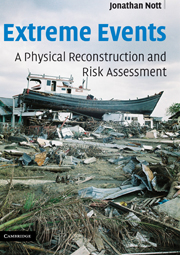8 - Volcanoes
Published online by Cambridge University Press: 18 December 2009
Summary
HISTORICAL VOLCANOES
Volcano and eruption characteristics
More than 90% of all volcanoes are associated with Earth's plate tectonic boundaries. Hot spots account for the remaining 10%. The most explosive volcanism occurs where plates converge, principally at subduction zones, but over 80% of magma released from the mantle by volcanic eruptions occurs at oceanic spreading centres (Abbott, 1999). Eruptions at spreading centres and over hot spots tend to be less violent than at convergent plate margins. This is principally because the former locations sit over the high-temperature asthenosphere where the rock has low densities of SiO2. The pulling apart action by the oceanic plates here makes the upward movement of magma through fissures easier. The basaltic magma that rises at oceanic spreading centres releases gas easily and produces lava flows rather than explosive eruptions. This magma also has a high temperature with low viscosity. Because of these characteristics, these types of volcanic eruptions are the least hazardous to humans. Magma that is released at subduction zones incorporates subducted crust resulting in a higher water and SiO2 content. It also has a higher viscosity (resistance to flow in a liquid) and explosive potential as gas is trapped in the magma and not easily released.
Hot spots are located where plumes of slowly rising mantle rock occur. This mantle rock is considerably hotter than the surrounding rock resulting in the mantle plume having a lower viscosity allowing it to rise.
- Type
- Chapter
- Information
- Extreme EventsA Physical Reconstruction and Risk Assessment, pp. 202 - 221Publisher: Cambridge University PressPrint publication year: 2006



